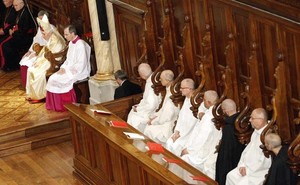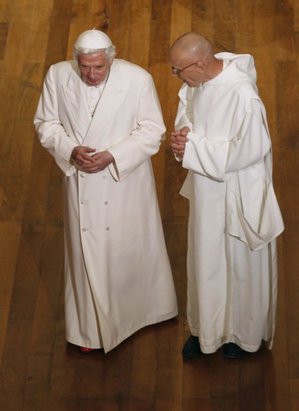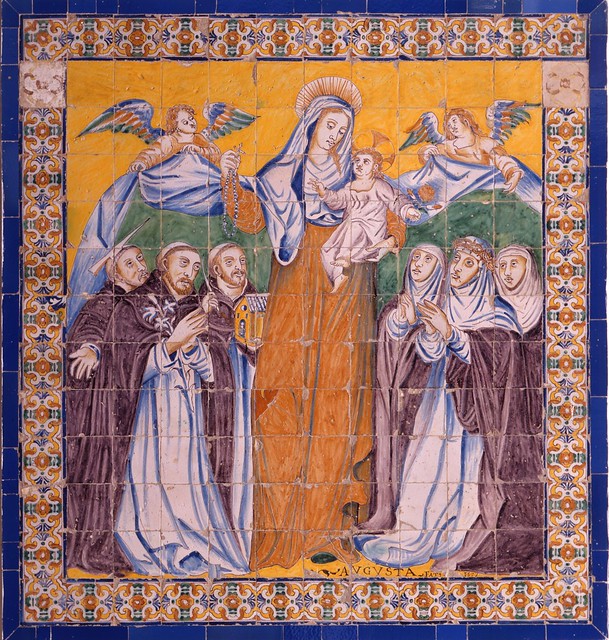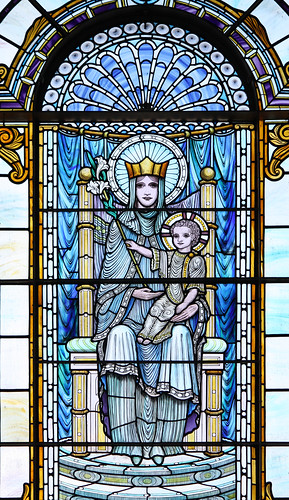
AT HOME. Members of the Hermits of the Blessed Virgin Mary of Mount Carmel in Texas in their chapel: from left, Brothers Joseph Mary and John David, Father Fabian Rosetti and Brothers Jason, Martin Mary and Albert Mary.
– Courtesy of the Hermits of the Blessed Virgin Mary of Mount Carmel
CHRISTOVAL, Texas — Father Fabian Rosetti had a dream. The Cuba-born Carmelite wanted to build a hermitage on land that would provide monks with the necessary isolation they needed.
He found a suitable tract in central Texas, but the man who owned it made it clear that he was not willing to help.
"He was very blunt," Father Rosetti recalled of the encounter he had with the landowner in 1991. "He said to me, 'I don't like you, and these are my reasons why: One, you're Catholic. Two, you're a priest. And three, you're Hispanic.' He had no plans whatsoever of helping me."
Yet, this outspoken Protestant would eventually soften and agree to let Father Rosetti use 200 acres of his property.
"When God wants something to get done, it gets done, and he uses whomever he pleases to get it done," the priest surmised. "St. Thérèse of Lisieux said that her invincible arms were prayer and sacrifice, and that continues to be true for Carmelites today."
And that, perhaps, is the case with religious life today, particularly the Catholic religious brotherhood. Once almost as omnipresent as women religious, religious brothers have become almost an endangered species. Their numbers in the U.S. have declined sharply in recent decades. According to the Center for Applied Research in the Apostolate (CARA), there were 22,707 religious priests in 1965, but only 12,629 in 2011. The center reports 12,271 religious brothers in 1965, with the number falling to 4,606 in 2011.
But new religious communities such as Father Rosetti's Hermits of the Blessed Virgin Mary of Mount Carmelhave emerged in recent years, offering signs of hope. From Wyoming to Connecticut, men are being drawn to lives of intense prayer and labor within the framework of poverty, chastity and obedience, and to communities that are overtly faithful to Church teaching.
The breakthrough with the landowner in Texas was only the beginning of a witness to the local Christian community. Through the deep commitment to prayer and work displayed by the Hermits of the Blessed Virgin Mary of Mount Carmel, local Protestants gradually became less hostile and more willing to help.
In fact, the assistance needed to build a hermitage chapel was given mostly by non-Catholics.
"We had about 50 men working together to build our chapel, and almost all of them were Protestants. Can you imagine that?" said Father Rosetti. "Now, about half the people who come to our Mass in the chapel on Sunday are Protestants. I don't give them holy Communion, but they attend Mass, and I preach pure Catholic doctrine."
'A Vocation, Not a Vacation'
Sound Catholic doctrine is greatly valued among new men's religious communities, among them the Franciscan Brothers of the Eucharist, based in Meriden, Conn. Their website states unequivocally: "We fully believe and support the teachings of our Holy Father and the Roman Catholic Church."
The Church's teaching on the Eucharist anchors and nourishes the order's community life. Brother Leo Maneri stated, "Our day is centered on the Eucharist. We rise early, recite Morning Prayer, attend Mass, work during the day, and then return to the Blessed Sacrament for evening prayer. Jesus is the very foundation of our community life, so everything we do emanates from him."
"There is variety in our work, but what remains unchanged is our prayer life centered around the person of Jesus Christ in the Eucharist," Brother Maneri said. "Once there is a firm foundation of respect and veneration for the dignity of Jesus Christ, then respect for the dignity of others is made possible. This is in harmony with our counterpart order, the Franciscan Sisters of the Eucharist."
Upholding the dignity of the human person is the brothers' primary charism. Since the community began in 2002, the brothers have engaged in many activities, including public pro-life prayer vigils, counseling the mentally ill, caring for the elderly and coordinating outdoor adventure programs for youth.
"We see work as an opportunity to share as co-creators with God in building up the Church," Brother Maneri explained. As we give of ourselves in hard work, we are transformed by the power of communal effort and interaction with the elements of God's creation. It's a Franciscan way of seeing things."
Brother Maneri sees work and community life in general as a joyful challenge: "There's a misconception in some minds that religious life is a prolonged vacation. There is an element of solitude, but it's not idleness. We enjoy working with our hands, especially in the outdoors. Like many religious communities, we grow vegetable gardens, flower gardens, and raise small farm animals, such as chickens. It's a vocation, not a vacation."
Solesmes in Oklahoma
Men with a vocation to the contemplative life have been attracted to Our Lady of Clear Creek Abbey in Hulbert, Okla., since 1999. The Benedictine Monks of the Solesmes Congregation, a community of strict observance, chant the Divine Office in Latin and celebrate Mass according to the 1962 Roman Missal.
Abbey visitors appreciate the solemnity and reverence of the liturgical celebrations, one prominent aspect of which is chant. Abbot Philip Anderson observes that "Gregorian chant has a simplicity, respect and peace that is very conducive to divine worship. The majesty of God is made manifest by a decrease of attention on our own personalities and an increase of attention on the divine. This is what prayer is about."
While not everyone can visit the abbey in person, the monks have made CD recordings available at their website. They hope listeners will feel as though they are present with the monks in an atmosphere of prayer, which is the first pillar of the Rule of St. Benedict.
"Prayer and work — ora et labora — are central to our rule," said Abbot Anderson. "The primary aim of the monks is contemplation, but this is complemented by rigorous work. I've sometimes called it 'spiritual boot camp' to those interested in joining."
The day for this "spiritual boot camp" begins at 4:50am with morning prayer, continues with Mass and more prayer, then spiritual reading and a second Mass. Study or work is followed by more prayer, along with three hours of manual labor, more prayer, spiritual reading, and … more prayer.
"Our charism is contemplation," said the abbot. "While we do manual labor and other tasks on a daily basis, the very foundation and heart of our life is prayer. Without prayer, we would not be able to engage in the other things we do, so that remains unchanged."
Abbot Anderson believes unnecessary change plagued the religious life from the mid-1960s to the late-1990s. "Following the Second Vatican Council, an unrealistic enthusiasm for change — without adequate discernment — brought about the loss of a great number of vocations," he stated. "In the later 1990s a healthier attitude among candidates for the religious life began to appear."
These candidates, often coming from what is referred to as the "John Paul II Generation" or "Benedict Boomers," are less inclined to dissent from Church teachings or wish for a rejection of discipline in the religious life. Abbot Anderson sees these as prime reasons for the success of newer religious vocations: "They are having much better success in persevering in their vocation, albeit not without many challenges."
Worth the Sacrifice
Challenges are just what many young men are looking for, according to Michael Wick, executive director of the Institute on Religious Life. "Young people today want to be drawn to a clear ideal that is worth sacrificing for. If there's no clear goal, then discipline doesn't really have a place in religious life anymore. If that's the case, why bother joining? No, young men today take religious life seriously and joyfully accept the necessary sacrifices that are a part of it."
Wick notes that this is essential to any vocation. "Whether it's priesthood, religious life, marriage or dedicated single life, you have to take it seriously and do what's necessary to keep it alive," he said. "One thing that keeps a vocation alive is other people with a different vocation keeping theirs alive. I'm married with four children, and it's a great support and inspiration to see dedicated priests and religious living out their vocations."
Wick has observed that solid marriages help religious vocations as well: "Couples living out their vows can inspire religious to do the same, but even more than that, marriages are where religious vocations come from in the first place. Married people can help to promote religious vocations by passing on their faith to their children through word and deed. Religious vocations will then become more common because many of the myths and misconceptions about religious life will have been pre-empted.
One popular misconception is that religious brothers are men who are not smart enough to be priests. "Catholics tend not to have a problem with women religious, but when it comes to non-ordained men religious, they are a bit uncertain," Wick said. "What they might not realize is that a religious brother has just as legitimate a consecrated vocation by striving to be a brother to all."
Some religious communities of men include no priests at all and look outside their communities to have their sacramental needs met. This is the case with the Franciscan Brothers of the Eucharist. Others include priests on an as-needed basis, which is true with the Hermits of the Blessed Virgin Mary of Mount Carmel. Father Rosetti is the only priest in the Texas hermitage, and he points out that this is similar to the first desert monks, who were mostly laymen. The Benedictine Monks of Clear Creek Abbey have 13 priests and 26 others (brothers and students).
Wick sees all of these communities as unique expressions of the Holy Spirit in the Church. "There are so many different charisms," he said. "We have the older, more established orders, newer communities in the tradition of an older order, and then altogether new orders. There's something for everyone, but a common thread among the communities doing well is their faithfulness to the magisterium."
While overall numbers are down, there is a surprising, quiet revival of religious men in the United States, and Abbot Anderson believes "if these young people continue to pray, they will rebuild religious life in America."
Register correspondent Trent Beattie writes from Seattle.
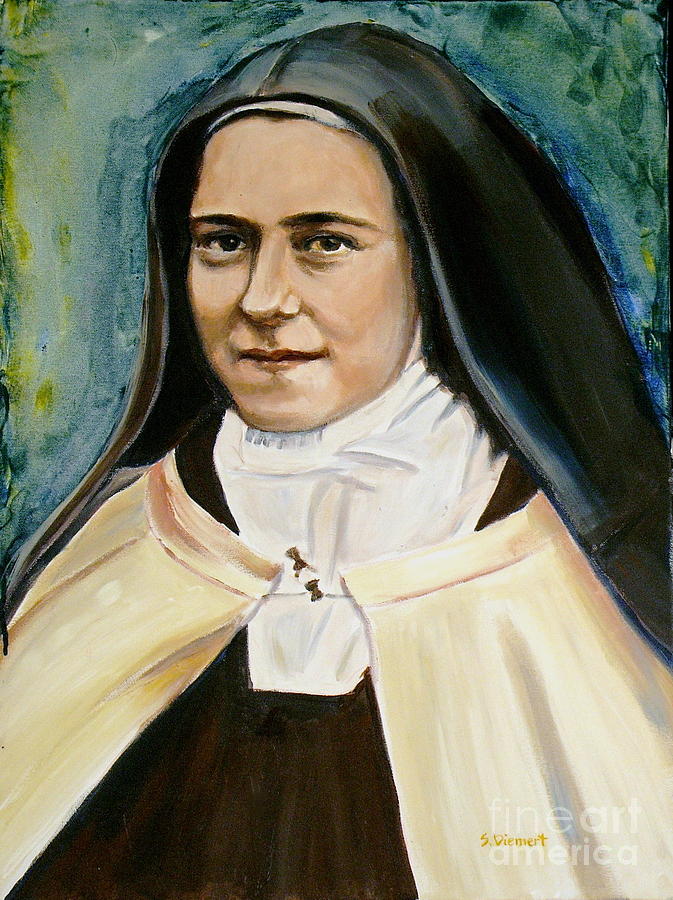


 Pope Francis said on Friday the proof of whether we are true Christians is shown by our ability to endure humiliations with joy and patience. Speaking at his morning mass in the Vatican's Santa Marta guesthouse, the Pope stressed this need for sacrifice in the Christian's life of faith.
Pope Francis said on Friday the proof of whether we are true Christians is shown by our ability to endure humiliations with joy and patience. Speaking at his morning mass in the Vatican's Santa Marta guesthouse, the Pope stressed this need for sacrifice in the Christian's life of faith. 



 Some saints I feel I know a little better because I have met someone like them. But I have never met anyone like St. John de Brébeuf, the Jesuit missionary and martyr. Large and handsome, his presence commanded attention. A brilliant student, gifted linguist, and competent manager, he could make things happen. I have met others like that, but none like this saint who was willing to endure anything if only he could thank Christ by giving his life for the salvation of others.
Some saints I feel I know a little better because I have met someone like them. But I have never met anyone like St. John de Brébeuf, the Jesuit missionary and martyr. Large and handsome, his presence commanded attention. A brilliant student, gifted linguist, and competent manager, he could make things happen. I have met others like that, but none like this saint who was willing to endure anything if only he could thank Christ by giving his life for the salvation of others. Alexandre de Rhodes, SJ, was a missionary in Vietnam.
Alexandre de Rhodes, SJ, was a missionary in Vietnam.

